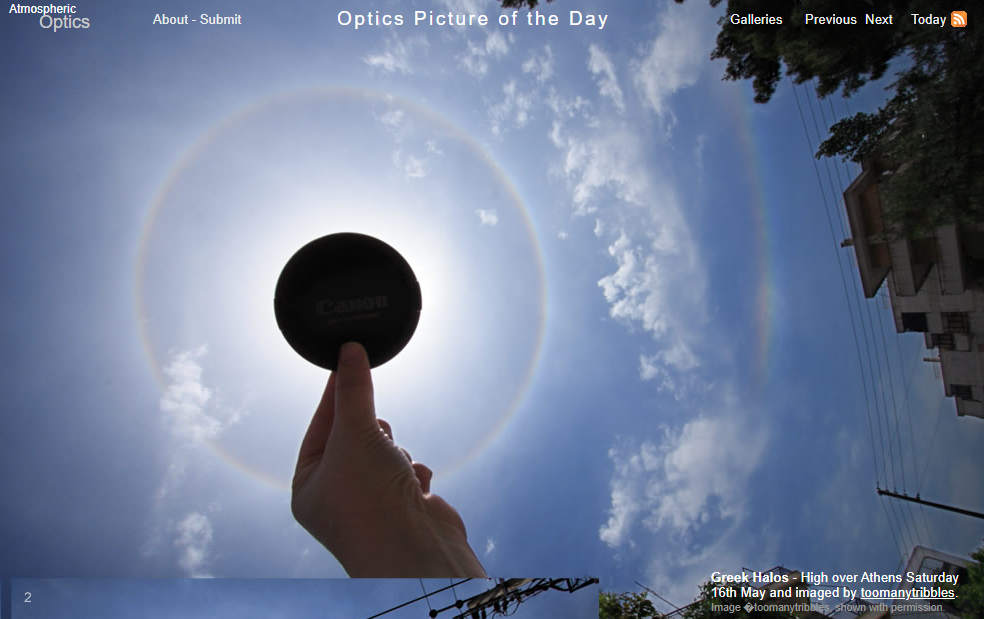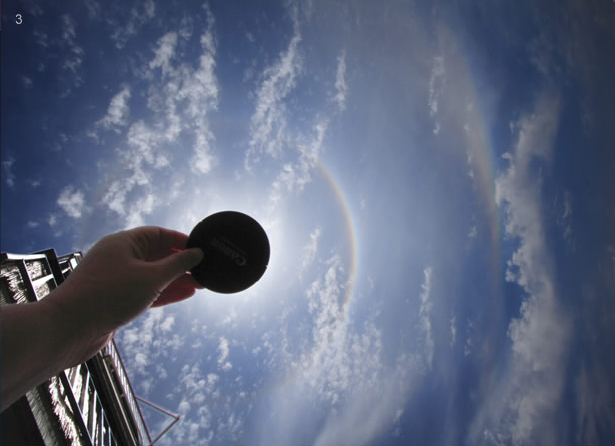Athens & Halos
Athens & Halos: A Fascinating Display of Atmospheric Optics
When it comes to atmospheric optics, Athens, Greece offers a stunning showcase of halos. These optical phenomena occur when light interacts with ice crystals in the atmosphere, creating a mesmerizing display of colors and arcs. In this article, we will delve into the intricacies of halos observed in Athens and explore the scientific explanations behind these captivating atmospheric events.
The Bright Inner Halo: A Circumscribed Halo
One of the most prominent halos observed in Athens is the bright inner halo, which appears as a circular ring around the sun. This halo is formed by horizontal column crystals in the cirrus clouds present in the Athenian sky. At a high sun altitude of 68°, the inner halo is nearly circular and often mistaken for the more common 22-degree halo. However, circumscribed halos like this one have sharper and more intense colors, adding to their visual allure.
The Arc with Widely Spread Colors
To the right of the sun in the top image, we can observe an arc with widely spread colors. This phenomenon is the result of refraction and dispersion of light through crystal faces that are at 90° angles to each other. The exact nature of the crystals responsible for this arc is uncertain, but they could be column crystals, giving rise to an infralateral arc. Alternatively, they might be horizontal plate crystals, producing a circumhorizon arc. Both arcs could be present simultaneously, contributing to the vibrant display in the Athenian sky.
Distinguishing Between the Two Arcs
Differentiating between the circumhorizon arc and the infralateral arc can be done through direct visual observation. The circumhorizon arc appears parallel to the horizon, while the infralateral arc curves upwards from the horizon at its ends. These arcs offer a unique visual experience and add an extra layer of intrigue to the atmospheric optics observed in Athens.
Column Crystals and the Parhelic Circle
Column crystals play a significant role in creating another fascinating phenomenon known as the parhelic circle. When the sun is high in the sky, a tiny parhelic circle can be observed, reflecting light off the end faces of column crystals or the side faces of plate crystals. This circle appears much smaller in comparison to its actual extent when the sun is at a lower position. Numerous internal ray paths contribute to the formation of the parhelic circle, resulting in a stunning display of optical effects.
The Pioneers of Atmospheric Optics in Athens
It is intriguing to note that Athens and Greece, in general, hold historical significance in the study of atmospheric optics. It was here that renowned thinkers like Anaxagoras (c. 500-428 BC) and Aristotle (384-322 BC) first realized the nature of halos and rainbows. These early scholars were among the first to attribute these phenomena to the scattering and reflection of light by objects in the atmosphere. Their groundbreaking insights paved the way for further scientific exploration into atmospheric optics.
Exploring Halos in Athens: A Visual Delight
The captivating halos observed in Athens serve as a testament to the beauty and complexity of atmospheric optics. Whether it's the vibrant inner halo, the spread of colors in the arc, or the mesmerizing parhelic circle, each phenomenon offers a unique visual delight. The interplay between sunlight and ice crystals in the Athenian sky creates a dynamic display that leaves spectators in awe.
In conclusion, Athens stands as a remarkable location for observing halos and exploring the wonders of atmospheric optics. The combination of high-sun circumscribed halos, intriguing arcs with widely spread colors, and the enchanting parhelic circle makes for an unforgettable experience. As we continue to unravel the mysteries of atmospheric optics, let us marvel at the breathtaking displays that nature presents to us, reminding us of the wonders that lie just above our heads.




Greek Halos - High over Athens Saturday 16th May and imaged by toomanytribbles. Image �toomanytribbles, shown with permission.
The bright inner halo is a high-sun (68° altitude) circumscribed halo produced by horizontal column crystals in the Athenian cirrus. This halo is almost circular at that solar altitude and often mistaken for the common 22 degree halo. Circumscribed halos, as here, have sharper more intense colours.
To the right in the top image (below the sun!) is an arc with widely spread colours, the result of refraction and dispersion through crystal faces at 90� to one another. The crystals making it are less certain however. They could be more column crystals giving an infralateral arc. They could be horizontal plate crystals producing a circumhorizon arc which is not particularly rare at the 38� latitude of Athens. Both arcs might be present.
The two arcs are compared in the HaloSim ray tracing at page bottom. The simulation used only a mixture of column and plate crystals. The arcs in the sky are most easily distinguished by direct visual observation. The circumhorizon is parallel to the horizon whilst the infralateral arc curves upwards from the horizon at its ends.
Image (2) shows another manifestation of column crystals - a high-sun parhelic circle tiny in comparison to its vast extent when the sun is low. Light reflects off column end faces or plate side faces to make the parhelic circle. Many other internal ray paths also contribute.
The crystals were real, the halos themselves had no real corporeal existence instead being only bundles of light rays reaching the eye and camera.
It was right here in Athens and Greece that Anaxagoras (c500-428BC), Aristotle (384-322BC) and others were the first to realise this and attempt to explain halos and rainbows as scattering and reflection by objects in the atmosphere.
Note: this article has been automatically converted from the old site and may not appear as intended. You can find the original article here.
Reference Atmospheric Optics
If you use any of the definitions, information, or data presented on Atmospheric Optics, please copy the link or reference below to properly credit us as the reference source. Thank you!
-
<a href="https://atoptics.co.uk/blog/athens-halos/">Athens & Halos</a>
-
"Athens & Halos". Atmospheric Optics. Accessed on December 22, 2024. https://atoptics.co.uk/blog/athens-halos/.
-
"Athens & Halos". Atmospheric Optics, https://atoptics.co.uk/blog/athens-halos/. Accessed 22 December, 2024
-
Athens & Halos. Atmospheric Optics. Retrieved from https://atoptics.co.uk/blog/athens-halos/.